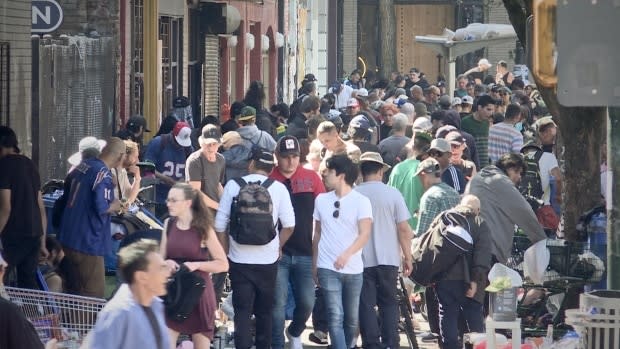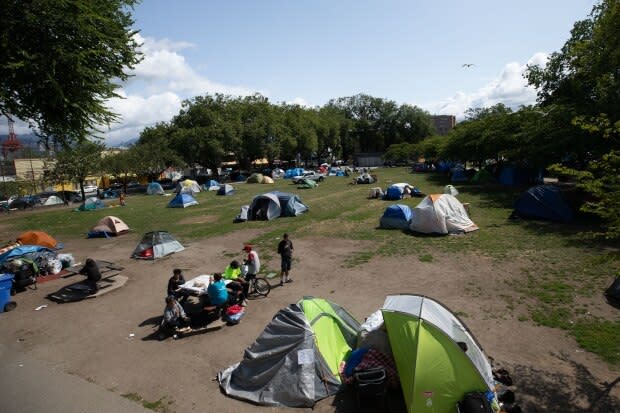The biggest change in the Downtown Eastside isn't the crime or homelessness. It's the geography.
The state of Vancouver's Downtown Eastside, long one of the most discussed neighbourhoods in Canada, has gotten dramatically worse in the last couple of years.
Or so the narrative goes.
"It is in the worse shape I've seen it my whole time here, since the '80s," said Mayor Kennedy Stewart earlier this month, beginning a series of stories examining the area between Vancouver's downtown core and residential zones to the east. For decades, politicians have tried — and mostly failed — to bring a turnaround in the troubled neighbourhood.
In most cases, you would fact-check such claims by looking at quantifiable data: homeless counts, overdose deaths, crime statistics.
But the number of homeless people in Vancouver, the majority of whom are in the DTES, has only gone up from 2,138 to 2,223 since 2017, a four per cent increase.

Overdose deaths in Vancouver are down 26 per cent this year, after years of increasing during the fentanyl crisis.
And criminal acts recorded by Vancouver Police for the two neighbourhoods the DTES intersects (Strathcona and the Central Business District) have increased by four to six per cent this year, after increases of six to seven per cent in 2018.
The numbers don't show evidence that things have grown significantly worse since 2017. So why do so many feel we're at an inflection point?
The answer has less to do with quantifiable numbers, and more to do with what happens, four years into an overdose crisis, when a community is squeezed into a smaller and smaller area.

Underreported crime
First, a couple of caveats: one thing people contacted for this story agreed on — including Vancouver Coun. Pete Fry, a Strathcona resident for 30 years — was that police statistics couldn't tell the whole story.
"They don't show up for a number of hours and typically there's nothing they can do about whatever it is," said Fry, adding that people don't call the police anymore for smaller petty crimes and general disorder.
At the same time, while most crime rates haven't risen much in recent years, the rate of thefts from vehicles in the area has skyrocketed — creating a new type of shared anecdote among residents throughout the city: "There's more of that grab-and-run kind of theft," said Fry.
"There used to be a code," he said. "People would ... show respect for children and families. And that doesn't happen as much anymore."
Smaller geographic base?
But a big reason why things seem much worse comes down to geography and density.
"There's been a lot of gentrification in that area," said Dr. Mark Tyndall, a leader with the province's Opioid Overdose Response team. "It's really changing, it's pushing people more out on the streets ... and what we consider the DTES has dramatically shrunk," said Tyndall, who has spent 20 years working in the area.
Put simply, the total number of homeless people and criminal activity in the "Downtown Eastside" may not have significantly increased.
However, the area where people congregate is now just a few blocks on Hastings and Cordova streets, roughly between Carrall Street and Jackson Avenue, causing greater visibility and greater stress on the system.
"It's kettling," said Karen Ward, a community advocate and drug policy adviser for the city, referring to the controversial police practice of confining a large group of protesters to a small area.
"[It's] a very concentrated four blocks now. And people are crammed in. People are in [Oppenheimer] park because there's literally nowhere on the street for them to go, and other places where people might have found a little bit of privacy and refuge no longer exist."
Add in a long summer with a prominent tent city, and a community that has lost hundreds of people to overdoses with no end of the fentanyl crisis in sight, and there's little doubt why the current "crisis" feels different than past ones in the neighbourhood.
What remains to be seen is whether the resolution will be any more successful than past ones.
"It would require quite a major investment, and I don't think there's much appetite for that.... Ten thousand people have actually died in Canada [from overdoses] in the last three years and it seems like we haven't mounted hardly any response," said Tyndall.
"We really haven't taken this seriously enough. And if 10,000 people dying doesn't change it, I guess I can't be that optimistic."


